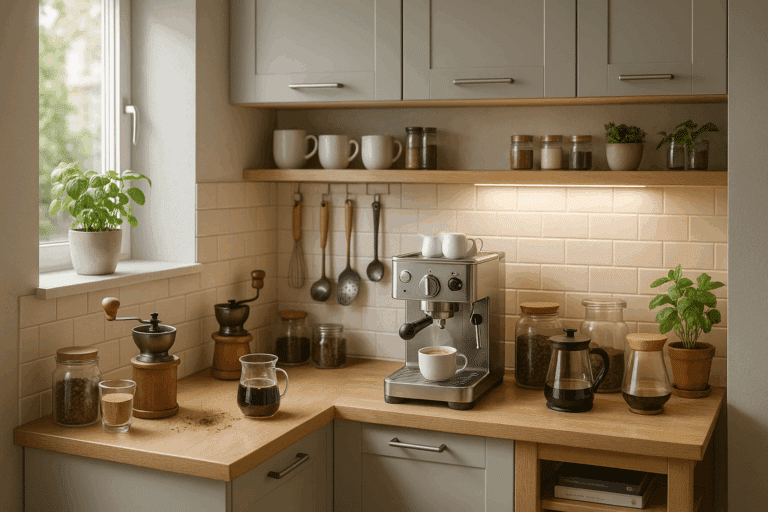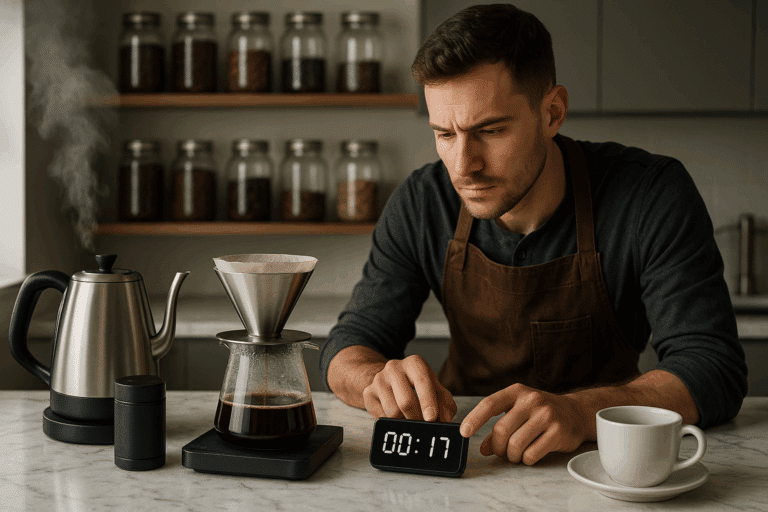As early morning light peeks through the window, the anticipation of a warm, flavorful cup of coffee can be the ultimate motivation to start the day. For those who consider coffee a staple, the French press method can elevate your daily cup into an art form. ☕️
Despite its simplicity, the French press, also known as a press pot or plunger pot, provides an exceptionally robust and pure coffee taste. By allowing the coffee grounds to steep directly in hot water, the French press method extracts the coffee’s full flavor, delivering a coffee experience unlike any other brewing methods.
In this guide, I’ll be sharing everything you need to know about mastering the art of French press. From selecting the right coffee beans to understanding the precise brewing time, this comprehensive guide will provide all the necessary tools and techniques to help you brew a perfect cup of French press coffee every time. 🕰️
Why Choose French Press?
The French press method is not merely about brewing coffee; it’s about appreciating the beauty of the process, the intricate details, and the rewarding result. Not to mention, the French press method is admired by coffee connoisseurs for its ability to deliver a rich and full-bodied cup of coffee, preserving the natural oils and flavors of the coffee beans.
Also, the French press is a versatile brewing device. Apart from coffee, it can be used for making tea, cold brew, or even frothing milk. But, most importantly, it’s about the control you get over the entire brewing process. By controlling the water temperature, steeping time, and coffee grind size, you can fine-tune your brew to match your taste preference perfectly. 🎯
Topics Covered
This ultimate guide will cover a wide range of topics to ensure a thorough understanding of the French press brewing method:
- Choosing the right coffee beans for French press
- The importance of coffee grind size
- Understanding the role of water temperature in French press brewing
- A step-by-step guide to brewing French press coffee
- Common mistakes to avoid while using French press
Whether you’re a coffee aficionado or a beginner wanting to learn more about the art of coffee brewing, this guide will provide insights and instructions on how to get the most out of your French press. Let’s delve into the world of French press brewing and discover how you can make every cup of coffee a masterpiece. 🎨
Ready? Grab your coffee mug, put on your favorite playlist, and let’s dive into the art of mastering French press coffee.
A Glimpse into the History of French Press
Before we jump into the brewing process, let’s take a quick detour into the history of French press. Knowing how this simple yet effective coffee brewing device came to be can deepen our appreciation for it, making each cup of French press coffee even more enjoyable. 🏛️
As we journey through the world of French press brewing, remember that coffee brewing is both a science and an art. It’s about understanding the technicalities and embracing the process. It’s about passion, patience, and precision. And above all, it’s about enjoying a perfect cup of coffee, brewed just the way you like it.
So, are you ready to unlock the secrets of French press brewing? Let’s get started.
Understanding the French Press Method
One of the most favored methods of brewing coffee globally is the French Press technique. This method involves steeping coffee grounds in hot water and then separating the grounds from the liquid by pressing a plunger through a cylinder. It results in a rich and robust coffee flavor that is adored by coffee enthusiasts worldwide. However, mastering the art of French Press requires a thorough understanding of various factors such as the right coffee to water ratio, the ideal brewing time, the grind size, and the water temperature.
Before diving into these factors, it is essential to understand the history and mechanics of the French Press method. Contrary to its name, the French Press was first patented by an Italian designer, Attilio Calimani, in 1929. Since then, it has undergone several modifications and improvements, resulting in the modern French Press we know today. The mechanism of a French Press is fairly simple, which contributes to its popularity. It consists of a cylindrical beaker (usually glass or stainless steel), a mesh filter, and a plunger. This simplicity not only adds to the aesthetics of the coffee maker but also allows the user to have total control over the brewing process.
In terms of mechanics, when you add hot water to the coffee grounds in the beaker, it immerses and steeps them, extracting the coffee’s oils and flavors. After a certain steeping time, you press the plunger down, which pushes the grounds to the bottom of the beaker, separating them from the brewed coffee. This simple yet effective process results in a uniquely flavorful and full-bodied coffee.
Mastering the French Press: The Ultimate Guide
Mastering the French Press method involves understanding and correctly implementing the four crucial elements: the coffee to water ratio, the brewing time, the grind size, and the water temperature.
Coffee to Water Ratio
The coffee to water ratio is perhaps the most critical factor in brewing the perfect French Press coffee. It determines the strength of your coffee, and getting it right can make the difference between a perfectly balanced cup and one that is either too strong or too weak. The ideal ratio is generally 1:15, meaning one part of coffee to fifteen parts of water. However, this can be adjusted according to personal preference. For a stronger cup, you could use a 1:10 ratio, while for a milder flavor, a 1:17 ratio would be suitable.
Brewing Time
The next critical factor is the brewing time. For French Press, the recommended brewing time is between 4 to 5 minutes. Shorter brewing times can result in under-extraction, leading to a weak or sour taste. On the other hand, longer brewing times can result in over-extraction, leading to a bitter taste. Thus, maintaining the optimal brewing time is crucial in achieving a balanced flavor.
Grind Size
The grind size is another important factor to consider. For French Press, a coarse grind is recommended. A fine grind may pass through the mesh filter, leading to a cloudy and gritty brew. On the other hand, a coarse grind will ensure that the water can circulate freely around the coffee particles, resulting in a clean and robust brew.
Water Temperature
Finally, the water temperature plays a significant role in the extraction process. The optimal water temperature for French Press is between 195 to 205 degrees Fahrenheit. A lower temperature may result in under-extraction, while a higher temperature may lead to over-extraction.
To get a visual understanding of these elements, watch the video titled “How to Brew Perfect French Press Coffee Every Time” by the “Seattle Coffee Gear” YouTube channel. It provides a step-by-step guide to brewing the perfect French Press coffee.
Comparative Analysis: French Press vs. Other Brewing Methods
While the French Press method is widely revered for its simplicity and the robust flavor it produces, how does it compare to other brewing methods? Let’s examine this through a comparative analysis with two popular brewing methods: the Drip Coffee method and the Espresso method.
| Brewing Method | Flavor Profile | Brew Time | Grind Size |
|---|---|---|---|
| French Press | Full-bodied, robust, rich | 4-5 minutes | Coarse |
| Drip Coffee | Clean, light, nuanced | 5-10 minutes | Medium |
| Espresso | Strong, concentrated, intense | 20-30 seconds | Fine |
As depicted in the table, each method has its unique flavor profile, brew time, and grind size. However, the choice between these methods ultimately boils down to personal preference and convenience. If you enjoy a full-bodied and rich flavor, the French Press method is the way to go. However, if you prefer a clean and light flavor, you might want to opt for the Drip Coffee method. On the other hand, if you are a fan of strong and intense coffee, the Espresso method would be your best bet.
For a more detailed comparison, check out the video titled “French Press vs Drip Coffee vs Espresso” by the “European Coffee Trip” YouTube channel. This video provides an in-depth comparison of these three brewing methods, discussing their pros and cons, and the flavor profile each method produces.
Perfecting Your French Press Technique
With the right understanding and practice, you can perfect the art of brewing coffee with a French Press. Remember, the key is to experiment and find what works best for you. Whether it’s adjusting the coffee to water ratio or the brewing time, these factors can be tweaked to suit your personal preference. So, grab your French Press and start brewing!
For additional tips and tricks, watch the video titled “5 Mistakes Every French Press Coffee Maker User is Guilty Of” by the “French Press Coffee” YouTube channel. This video provides valuable insights into common mistakes and how to avoid them for a perfect brew every time.
The art of French Press is a journey, not a destination. So, take your time, learn the process, and enjoy every sip of your perfectly brewed coffee. 🍵 Happy Brewing!

Conclusion
In conclusion, as we have traversed through the landscape of this intricate subject, it is apparent that the realm of IT and engineering is constantly evolving, packed with profound insights and breakthroughs. The exploration of these fields is like embarking on an intellectual adventure, offering us a glimpse into the fascinating world of technological advancements.
Let’s quickly recap the main points discussed in this article. We initially delved into the importance of understanding the basics of IT and engineering. Mastering the fundamentals is not only the stepping stone to learning more complex concepts, but it also helps to solve problems more effectively and efficiently. Additionally, we explored how the application of these concepts in real-world scenarios can significantly contribute to personal development and the progress of our society.
Next, we examined the significance of continuous learning and the role it plays in staying abreast of the latest developments in the field. As the saying goes, “Knowledge is power.” Continuous learning is the key to unlock that power.
We also discussed the remarkable impact of IT and engineering on various sectors, including healthcare, education, entertainment, and business. The integration of these technologies is reshaping our lives in unimaginable ways, enhancing efficiency, accuracy, and convenience in our daily tasks.
Moreover, we highlighted the exciting opportunities that lie ahead for those who are willing to dive deep into the world of IT and engineering. The future is undoubtedly bright, with an abundance of career paths, innovations, and discoveries waiting to be explored.
The importance of IT and engineering in today’s digital age cannot be overstated. They are integral elements of our modern world, driving the wheel of technological progress and enabling us to step into the future.
However, understanding and mastering these complex subjects is not an easy task. It requires commitment, curiosity, and a strong desire to learn. It’s a challenging journey, but it’s also rewarding. The knowledge gained will not only enrich your mind but also equip you with the tools needed to make a significant contribution to society.
I encourage you all to share your thoughts and experiences in the comments section below. Remember, knowledge increases by sharing but not by saving. So don’t hesitate to share this article with your friends, colleagues, or anyone who might benefit from it.
If you wish to delve deeper into these topics, I recommend visiting the following websites for more comprehensive information: IBM Information Technology and Engineering.com.
To all the aspiring engineers and IT enthusiasts out there, keep exploring, keep learning, and keep innovating. The world needs your brilliance. Remember, the sky is not the limit; it’s just the beginning. 🚀
Thank you for taking the time to read this article. I hope it has sparked a sense of curiosity and inspired you to embark on your own journey of discovery. 🌟
Stay tuned for more insightful articles like this one. Until then, happy learning! 📚
And as always, stay curious, stay inspired, and never stop learning. 💡
Finally, I would like to end with a quote that I believe encapsulates the spirit of this article: “The only source of knowledge is experience.” – Albert Einstein



